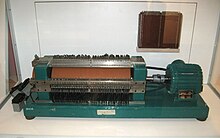BESK


BESK (Binär Elektronisk SekvensKalkylator, Swedish for "Binary Electronic Sequence Calculator") was Sweden's first electronic computer, using vacuum tubes instead of relays. It was developed by Matematikmaskinnämnden (Swedish Board for Computing Machinery) and during a short time it was the fastest computer in the world. The computer was completed in 1953 and in use until 1966. The technology behind BESK was later continued with FACIT EDB. A copy of BESK called SMIL was made for the University of Lund, and a copy of BESK made in Denmark was called DASK.
The team was initially led by Conny Palm, who died in December 1951, after which Stig Comét took over. The hardware was developed by Erik Stemme. Gösta Neovius and Olle Karlqvist were responsible for architecture and instruction set. It was closely modeled on the IAS machine for which the design team had retrieved drawings during a trip to the United States.
BESK was a 40-bit machine; it could perform an addition in 56μs and a multiplication took 350μs. The electrostatic memory could store 512 words. The instruction length was 20 bits, so each word could store two instructions. BEST contained 2400 "radio tubes" (vaccum tubes) and 400 germanium diodes (so it was partly solid state). The power consumption was 15 kVA.
Originally BESK had a British Williams tube memory with 40 cathode tubes. The memory was soon found to be insufficient and Carl-Ivar Bergman was given just a few weeks to build and install a ferrite core memory. To get finished before the deadline they hired housewives with knitting experience to make the memory. One of the new memory bits did not work at first, but it was easily cut out and replaced. The first calculations were done on April 1 1954 and BESK handled weather data for Carl-Gustaf Rossby and SMHI, statistics for Televerket, wing profiles for Saab Lansen and road profiles for Vägverket. During the nights FRA used BESK for decryption of radio messages. BESK was also used for calculations for the Swedish nuclear weapons program, but most calculations were done by SMIL. In 1957 Hans Riesel used BESK to discover a Mersenne prime with 969 digits - the largest prime known at the time.
BESK was developed by the Swedish Board for Computing Machinery (Matematikmaskinnämnden) a few years after the mechanical relay computer BARK (Binär Aritmetisk Relä-Kalkylator, Swedish for "Binary Arithmetic Relay Calculator").
SAAB rented computer time on the BESK to (probably, much was secret) make calculations of the strength of the Saab Lansen. In the fall of 1955 SAAB thought the capacity was insufficient and started working on SAABs räkneautomat SARA, "SAAB's calculating machine", which was going to be twice as fast as BESK. Some former BESK employees went to Facit and worked with the Facit EDB.
Trivia: "Besk" is Swedish for the taste "bitter". It is also the name of a traditional bitter made from distilled alcohol seasoned with the herb Artemisia absinthium L. local to the province of Skåne, in which Lund is located. Reportedly this was an intentional and unnoticed pun after officials denied usage of the name CONIAC (Conny [Palm] Integrator And Calculator, compare Cognac) for the BARK machine.
External links
- http://www.tekniskamuseet.se/templates/Page.aspx?id=20428 (in Swedish)
- http://www.treinno.se/pers/okq/besk.htm (in Swedish)
- BESK programmers manual (in Swedish)
